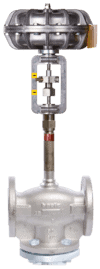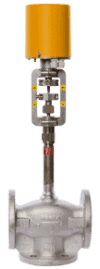District Heating & Cooling Application - HVAC
What is district heating and cooling, and how does district heating work? District heating is an underground infrastructure system where a central energy plant supplies thermal energy to multiple buildings and establishments. This thermal energy is usable in office buildings, apartment blocks, communities, etc.
District heating is a suitable heating and cooling alternative that eliminates the need for boilers in individual buildings. The central plant produces a constant supply of steam or hot water, which travels through highly insulated underground thermal piping networks to transfer the thermal energy to the buildings.
In business for over 126 years, the Baelz Automatic brand provides innovative, energy-saving systems for process heating and cooling applications. With our expertise and dedication to our customers, we can provide long-lasting, affordable district heating solutions.
Types of District Systems
There are two types of district heating system applications:
- Steam applications
- Hot water applications
Steam Applications
Heat distribution systems that use steam as a means of thermal heat transfer transmit superheated steam through the underground piping network. The temperature of the steam is elevated using a heat source, such as solar energy, natural gas, biogas, waste incineration, biomass, or recovered geothermal heat.
As the steam travels through the insulated pipes, the heat transfers to the buildings’ heating systems. Steam heating reduces energy wastage, making it a cost-effective and eco-conscious heating alternative.
Hot Water Applications
Using Baelz hydrodynamic jet pump technology, water is pumped to heat transfer stations that heat the water to 356°F/ 180°C. The water continues through the piping network to transfer the thermal energy from the water to the surrounding facilities. This method reduces the amount of electric pumps and the burning of fossil fuels, resulting in a more environmentally friendly heating system.
Baelz is an industry-leading supplier of major products applicable in a typical district heating or cooling system. Here are some mentions and applications of our products in district heating or cooling systems.
Baelz Steam Transfer Stations
Baelz’s steam transfer stations are applicable as space-saving Luxese Instant Heat system solutions for a steam network. Steam transfer stations are compact and diverse. They are also fully heat-insulated and mounted on brackets, ready for use. We can customize our steam transfer stations to meet your requirements and prepare them for installation.
Modular Heat Exchanger
Our modular heat exchanger provides flexibility in design combined with impressive system availability. The modular heat exchanger Modulo Baelz 147 is the most universally recognized and unique heat exchanger from Baelz.
Baelz Hydrodynamic Jet Pump
The Baelz hydrodynamic jet pump helps to distribute produced hot water. Supplying hot water using this technology positively impacts energy and material savings. It also simplifies the hydraulics of heating systems.
Furthermore, using the Baelz hydrodynamic jet pump saves electricity since there is no need for electric pumps. More importantly, using the jet pump leads to a significantly reduced return temperature compared with traditional technology, thus boosting efficiency in district heating networks.
Benefits of District Heating and Cooling Systems
- Energy efficiency. Compared to individual systems, centralized plant systems require less energy to heat and cool multiple facilities.
- Reduced emissions. Using district heating and cooling systems reduces outdoor and indoor air pollution due to less fossil fuel usage. They also reduce power consumption by reducing the size of building chillers and air conditioners.
- Simplify maintenance. The systems require less maintenance since there is a reduced need for investments in transmission infrastructure, such as on-site boilers.
- Reduced costs. District heating and cooling systems reduce the need for power generation investment, thus reducing associated costs.
District heating systems encourage the expansion of denser urban areas with mixed-use developments increasing sustainability. Finally, these systems increase space in buildings by reducing the need for chillers and boilers.
Partner with Baelz
At Baelz, our products are designed to meet different needs and goals, including effective district heating and cooling. From our steam transfer stations to our modular heat exchanger and the Baelz hydrodynamic jet pump, our products are designed and customized for maximum functionality, cost reduction, energy efficiency, and durability. Contact Baelz today to learn more or request a quote.


